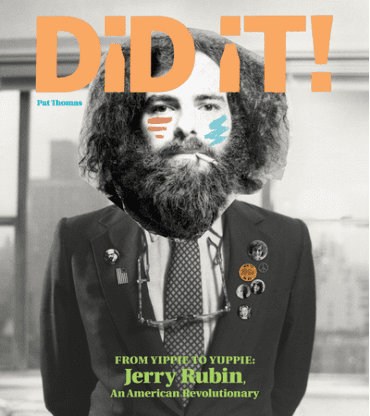A Great Gift For Readers Raging Against The Dying Of The American Light

It is safe to say without Pat Thomas this book would never have been written; and without Fantagraphics, it would never have been printed. Both had to commit deeply and lovingly to the subject of the glorious, gorgeous tome — the life story of the subversive and adventurous American Jerry Rubin. That Burbank-based Thomas (an A&R man for Light In The Attic Records) has scribed this biography with so much depth and cultural curation, and his Seattle-based publishing house has richly invested in making this private and political history of the counter-culture picador so beautiful to read and experience, says that there may be justice in this world for the truly adventurous picadors and bellwethers of our recent history.
This is historically the first biography of 60s Yippie-to-Yuppie founder Rubin, and it is a true art book in its replication of all the creative connections the activist and self-help businessman made from the 60s through to his bizarrely random death in the 80s. Thomas is an executive at Light In The Attic Records and works on deluxe reissues for other speciality labels; his love for music is reflected in the portions of the book about Bob Dylan, John Lennon, Phil Ochs, Country Joe McDonald, and Allen Ginsberg, who was fascinated by and participated in both the rock music and political upheaval of the time.
But Thomas, author of previous radical coffee-table encyclopedic history Listen, Whitey! The sights & sounds of Black Power 1965-1975 doesn’t stop with Rubin’sinteractions with contemporaneous iconic and progressive musicians during the age of Aquarius. There’s also interviews and profiles of his engagement with Eldridge Cleaver, the Weathermen, Timothy Leary, Norman Mailer, among others.
Who was Jerry Rubin and what were they all doing together? You may have heard of Rubin’s co-founder in the revolutionary movement the Yippies, Abbie Hoffman, and how the two of them did next-level cutting-edge activism and mingled it with a certain kind of performance art, trickster magic to garner maximum PR for their causes. Rubin not only co-founded the Yippies in virulently opposite the Vietnam War war, but took center stage at mocking the conformist establishment as a Chicago 8 defendant, in the wake of the police violence against protestors in the 1968 Chicago National Democratic Convention. That was a cruel and treasonous event by authorities that completely broke the heart of Ochs, the wickedly funny journalist-folksinger and Rubin’s dear friend. Then the two traveled Apocalypse Now style to Chile, and in the fall of Allende, discovered an even more monstrous expression of American domination over the poor and working classes.
The greatly talented Ochs committed suicide, but Rubin’s gaze turned both inward and out into society, and through endorsing lifestyle changes re-branded a new way of life coined “Yuppie” (Young Urban Professional) by the 1980s. The New Age movement was responsible for turning Rubin around in the “Me Decade” connecting them, which put the once-activist into the frame of thinking of everything one could do to self-empower. All these levels of change along the underbelly of American society have rarely been witnessed and related so deeply through one person’s involvement.
Throughout 75 interviews with people who knew and loved and hated Rubin, we see his Zelig-like connection to cultural change play out, as mavens of revolution either laid low, died out, or actually became invested in the running of capitalism, inventing neoliberalism. The honest salt of voices of movers and shakers like Paul Krassner, John Sinclair, John & Leni Sinclair, Black Power motivator Bobby Seale, and those originally involved in the seminal Berkeley Free Speech Movement tell the story around the charismatic and robustly driven Rubin. But of special note is the involvement of over 20 women such as Leni Sinclair, Rennie Davis, Stella Resnick, Werner Erhard, and Mimi Leonard who knew him as well, and stories both inspiring and darkly revealing are delivered directly for the first time.
It’s these stories of the weird and wonderful times of so much change in the United States, affected by a man seemingly addicted to ontological transformation, that makes such a crucial read for those willing to pick up the oversize and resplendently graphic storytelling in DID IT! If there is criticism to be made by this legendary publication, it’s that it may be too much of a good thing; all the art and photos and documents are published so extravagantly it’s hard to hunker down with the book and absorb it easily. Thus, a great present for those who wish to treat readers who crave revelation about how and why America has changed so much since the creation of the counter-culture, but also give them something nearly as big and bold as the United States itself to experience as well.
http://www.fantagraphics.com/didit


